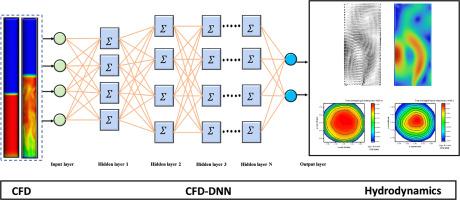计算流体动力学 (CFD) - 深度神经网络 (DNN) 模型,用于预测矩形和圆柱形气泡柱的流体动力学参数
IF 4.1
Q2 ENGINEERING, CHEMICAL
引用次数: 0
摘要
气泡塔在化学、生物化学、石油化学和石油工业中无处不在,但由于其复杂的流体力学原理,其设计和放大十分复杂。液体速度和气体滞留是影响气泡塔中混合、传热和传质的关键流体力学参数之一。CFD 被公认为是估算关键流体力学参数的有力工具,但需要大量的计算资源、时间和专业知识。这些局限性限制了 CFD 在需要实时处理的流体力学模拟中的实际应用,其中包括大规模的气泡柱模拟。为了克服这些限制,我们开发了 CFD-DNN 模型,用于预测各种运行条件下的时间平均气体滞留量和轴向液体速度。DNN 模型是利用矩形(尺寸长=0.2 米、宽=0.05 米、高=1.2 米)和圆柱形(直径 0.19 米)气泡塔的 CFD 数据进行训练的。这些数据涵盖了一系列运行条件和各种流态。矩形气柱的表层气体速度被选定为 1.33 和 7.3 mm/s,而圆柱形气泡柱的表层气体速度被固定为 0.02 和 0.12 m/s。根据文献中的实验数据和 CFD 数据对 CFD-DNN 模型进行了验证。此外,还对 CFD-DNN 模型与现有文献中未见的新数据进行了测试,结果表明模型与这些数据的吻合度很高,这反映了模型出色的泛化能力。所提出的 CFD-DNN 方法通过缩短计算时间、降低计算费用和减少 CFD 模拟中的专业知识,改进了当前的 CFD 模型。使用不同的气体滞留和轴向液体速度指标对所开发的 CFD-DNN 模型的准确性进行了评估。对于矩形气泡柱,该模型的气体截留率 MSE 为 0.0001,轴向液体速度 MSE 为 0.0007。同样,对于圆柱形气泡塔,气体滞留的 MSE 值为 0.0009,轴向液体速度的 MSE 值为 0.0006。本文章由计算机程序翻译,如有差异,请以英文原文为准。

Computational fluid dynamics (CFD)- deep neural network (DNN) model to predict hydrodynamic parameters in rectangular and cylindrical bubble columns
Bubble columns are omnipresent in the chemical, bio-chemical, petrochemicals, petroleum industries, but their design and scale-up is complex owing to its complex hydrodynamics. Liquid velocity and gas holdup is one of the critical hydrodynamic parameters which effects the mixing, heat and mass transfer in bubble columns. CFD is widely recognized as a powerful tool for estimating critical hydrodynamic parameters but requires significant computational resources, time and expertise. These limitations restrict its practical use in hydrodynamic simulations that need real-time processing involving large-scale simulations of bubble columns. To overcome these limitations, CFD-DNN model is developed to predict the time averaged gas holdup and axial liquid velocity at various operating conditions. The DNN model was trained using CFD data that was produced for rectangular (with dimensions L=0.2 m, W=0.05 m, H=1.2 m) and cylindrical (with a diameter of 0.19 m) bubble columns. The data covers a range of operating conditions and various flow regimes. The superficial gas velocity for the rectangle column was selected at 1.33 and 7.3 mm/s, whereas for the cylindrical bubble column, it was fixed at 0.02 and 0.12 m/s. The CFD-DNN model was validated against the experimental and the CFD data from the literature. Further, the model was tested for new data that the CFD-DNN model has not seen with existing literature and showed good agreement with their data and it reflects the excellent generalization ability of the model. The proposed CFD-DNN approach improves current CFD models by providing shorter computing time, decreasing computational expenses, and reducing the expertise in CFD simulations. The accuracy of the developed CFD-DNN model was evaluated using different metrics for gas holdup and axial liquid velocity. For rectangular bubble columns, the model achieved MSE of 0.0001 for gas holdup and 0.0007 for axial liquid velocity. Similarly, for cylindrical bubble columns, the MSE values were 0.0009 for gas holdup and 0.0006 for axial liquid velocity.
求助全文
通过发布文献求助,成功后即可免费获取论文全文。
去求助

 求助内容:
求助内容: 应助结果提醒方式:
应助结果提醒方式:


